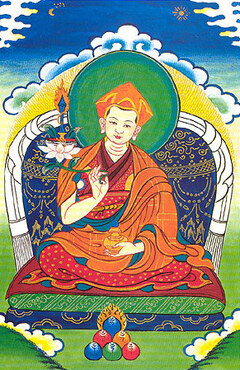Prayer to Dzogchen Rinpoche Incarnations
༄༅། །མདོ་ཁམས་རྫོགས་ཆེན་པའི་སྐྱེ་ཕྲེང་གསོལ་འདེབས་བཞུགས།
Prayer to the Garland of Rebirths of the Dzogchenpas of Eastern Tibet
by Jigme Lingpa
དུས་གསུམ་སྐྱེ་འགག་མེད་པའི་ཆོས་ཉིད་ཀྱང་། །
dü sum kyé gak mépé chönyi kyang
The dharmatā nature is beyond arising and ceasing and past, present and future,
སེམས་ཅན་ཁམས་ལ་གཟུགས་སྐུ་རྣམ་གཉིས་སུ། །
semchen kham la zuk ku nam nyi su
Yet still you appear in the two form kāyas1 within the realms of sentient beings—
སྣང་བའི་ངོ་མཚར་བདེ་གཤེགས་གཙུག་ཏོར་ཅན། །
nangwé ngotsar deshek tsuk tor chen
Marvellous buddha Ratnaśikhī,
མཚན་གྱིས་ངན་སོང་སྒྲོལ་ལ་གསོལ་བ་འདེབས། །
tsen gyi ngen song drol la solwa dep
Whose name alone liberates from the lower realms: to you I pray!
རྒྱུད་སྡེ་རྒྱ་མཚོའི་མངའ་བདག་ཀུ་ཀུ་རི། །
gyü dé gyamtsö ngadak ku ku ri
Kukkurīpāda, master of infinite classes of tantra,
འཕོ་ཆེན་རྡོ་རྗེའི་ས་བརྙེས་བི་མ་ལ་། །
pochen dorjé sa nyé bi ma la
Vimalamitra, who achieved the vajra state of great transference,
སྤྲོས་བྲལ་ཕྱག་རྒྱ་ཆེན་པོ་ས་ར་ཧ། །
trödral chakgya chen po sa ra ha
And Saraha, who realized the Great Seal beyond conceptual elaboration,
བསྟན་པའི་ཆུ་འགོ་གསུམ་ལ་གསོལ་བ་འདེབས། །
tenpé chu go sum la solwa dep
To these three fountainheads of the teachings, I pray!
ལྷ་སྲིན་བྲན་འཁོལ་རླངས་པ་ཤྲཱི་སེང་། །
lha sin dren khöl lanpa shiri sing
Śrī Siṃha, who bound gods and spirits into servitude,
འཁྲུལ་སྣང་བྲག་རི་བསྙིལ་བ་དཀོན་མཆོག་འབྱུང་། །
trul nang drak ri nyilwa könchok jung
Könchok Jungné,2 who destroyed the delusory appearances of rocks and mountains,
རྒྱལ་བསྟན་ཉིན་མོར་བྱེད་པ་ཁྲི་རལ་ཞབས། །
gyal ten nyinmor chepa tri ral zhap
And Tri Ralpachen, who caused the buddha’s teachings to shine like the sun,
བསྟན་པའི་རྩ་ལག་གསུམ་ལ་གསོལ་བ་འདེབས། །
tenpé tsa lak sum la solwa dep
To these three allies of the teachings, I pray!
གཏི་མུག་ལམ་སླང་གྲུབ་མཆོག་ཕག་ཚང་བ། །
timuk lam lang drup chok paktsang wa
Paktsangwa,3 who attained realization through bringing ignorance onto the path,
མི་ལ་བཞད་པའི་སྲས་གྱུར་བྱང་ཆུབ་རྒྱལ། །
mi la zhépé sé gyur chang chub gyal
Changchub Gyalpo,4 who became a heart-son of Mila Shyepe Dorje,
དྲུག་པ་སེང་གེའི་སྒྱུ་འཕྲུལ་དུས་གསུམ་མཁྱེན། །
drukpa sengé gyutrul düsum khyen
And Düsum Khyenpa,5 illusory manifestation of Senge, the sixth guide,
གྲུབ་པ་མཆོག་བརྙེས་གསུམ་ལ་གསོལ་བ་འདེབས། །
drubpa chok nyé sum la solwa dep
To these three supremely accomplished ones, I pray!
རྟོགས་པས་བདག་རྒྱུད་གྲོལ་བ་གླིང་རས་རྗེ། །
tokpé dak gyü drolwa ling ré jé
Lingjé Répa,6 who freed his mind through realization,
བླ་མར་མོས་གུས་མཐར་ཕྱིན་སྟག་ལུང་བ། །
lamar mögü tarchin taklung wa
Taklung Thangpa,7 who perfected devotion for the guru,
བརྟུལ་ཞུགས་གྲུབ་པ་ཨོ་རྒྱན་རང་བྱུང་བ། །
tulzhuk drubpa orgyen rangjung wa
And Orgyen Rangjungpa,8 who mastered yogic discipline:
སྒྲུབ་བརྒྱུད་བསྟན་འཛིན་གསུམ་ལ་གསོལ་བ་འདེབས། །
drubgyü tendzin sum la solwa dep
To these three holders of the teachings from the practice lineage, I pray!
གཞི་གསུམ་རྩ་བ་བརྟན་པ་བློ་གྲོས་བཟང་། །
zhi sum tsawa tenpa lodrö zang
Stable in the three foundational practices and with excellent intellect,
རྙིང་བསྟན་མདོ་སྨད་སྤེལ་ལ་སྨོན་ལམ་གྱི། །
nying ten do mé pel la mönlam gyi
You perfected the force of aspirations to spread the Nyingma teachings in Kham,
མཐུ་གྲུབ་པདྨའི་རིག་པ་འཛིན་པ་དང་། །
tu drup pemé rigpa dzinpa dang
Pema Rigdzin,9 holder of awareness in Padma’s line,
འགྱུར་མེད་ཐེག་མཆོག་ཅེས་ལ་གསོལ་བ་འདེབས། །
gyurmé tekchok ché la solwa dep
And Gyurme Thekchok Tendzin Pal Zangpo,10 to you I pray!
སྔ་འགྱུར་བསྟན་པའི་རྩ་བ་མདོ་སྒྱུ་སེམས། །
ngagyur tenpé tsawa do gyu sem
And Ngedön Tendzin Zangpo,11 who established traditions
ཡང་ཕུར་སངས་རྒྱས་མཉམ་པར་སྦྱོར་ལ་སོགས། །
yang pur sangyé nyampar jor la sok
Of great accomplishment-practices for the Kama traditions,
བཀའ་མའི་སྒྲུབ་ཆེན་ཕྲིན་ལས་སྲོལ་བཏོད་པའི། །
kamé drupchen trinlé söl töpé
Such as the fundamental teachings of the Early Translations: the Sūtra, Illusory Web and Mind,12
ངེས་དོན་བསྟན་འཛིན་བཟང་པོར་གསོལ་བ་འདེབས། །
ngédön tendzin zangpor solwa dep
And Yangphur (Viśuddha and Vajrakīlaya) and Sangye Nyamjor—to you, I pray!
ངེས་འབྱུང་རྒྱུད་བརླན་བྱང་ཆུབ་སེམས་གཉིས་ཀྱི། །
ngé jung gyü len chang chub sem nyi kyi
Inspire us with your blessings, so that we may prepare our minds with renunciation,
ཤིང་རྟས་དྲངས་པའི་སྨིན་གྲོལ་ལམ་མཆོག་ལ། །
shingté dranpé min drol lam chok la
And then, drawn along on the chariot of twofold bodhicitta,
རྟག་ཏུ་བསྟེན་གོམས་བགྱིས་པའི་དངོས་གྲུབ་ཀུན། །
taktu tengom gyipé ngödrup kun
Realize, in this very lifetime, all the accomplishments born of stable familiarity
ཚེ་འདི་ཉིད་ལ་མཐོང་བར་བྱིན་གྱིས་རློབས། །
tsé di nyi la tongwar chin gyi lop
With the supreme path of ripening and liberation!
ཞེས་པའང་དགེ་རྩེ་བླ་མ་འཇིགས་མེད་ངོ་མཚར་གྱི་ངོར་རིག་པ་འཛིན་པ་མཁྱེན་བརྩེའི་ལྷས་སོ།།
Written by the vidyādhara Khyentse Lha in response to a request from Getse Lama Jigme Ngotsar.13
| Translated by Adam Pearcey, 2017.
Version: 1.2-20231217
- ↑ The saṃbhogakāya and nirmāṇakāya.
- ↑ Langdro Lotsāwa, one of the disciples of Guru Rinpoche.
- ↑ A disciple of Nāropa.
- ↑ Changchub Gyalpo of Ngendzong was one of the six disciples of Jetsün Milarepa; he was likened to the stars and planets.
- ↑ The First Karmapa (1110–1193)
- ↑ Lingje Repa Pema Dorje (1128–1188), a disciple of Phagmodrupa Dorje Gyalpo (1110–1170).
- ↑ Taklung Thangpa Tashi Pal (1142–1210) was the founder of Taklung Monastery and the Taklung sub-branch of the Kagyü school.
- ↑ The siddha Orgyenpa Rinchen Pal (1230–1309?) was the founder of the tradition known as ‘Approach and Accomplishment of the Three Vajras’, one of the eight chariots of the practice lineage.
- ↑ The First Dzogchen Rinpoche (1625–1697)
- ↑ The Second Dzogchen Rinpoche (1699–1758).
- ↑ The Third Dzogchen Rinpoche (1759–1792).
- ↑ This refers to the Anuyoga root text, the Sūtra Which Gathers All Intentions, the Mahāyoga root tantra, the Web of Magical Illusion, and the Atiyoga root tantra of Semdé, 'The All-Creating King' (Kunjé Gyalpo).
- ↑ b. 1763
